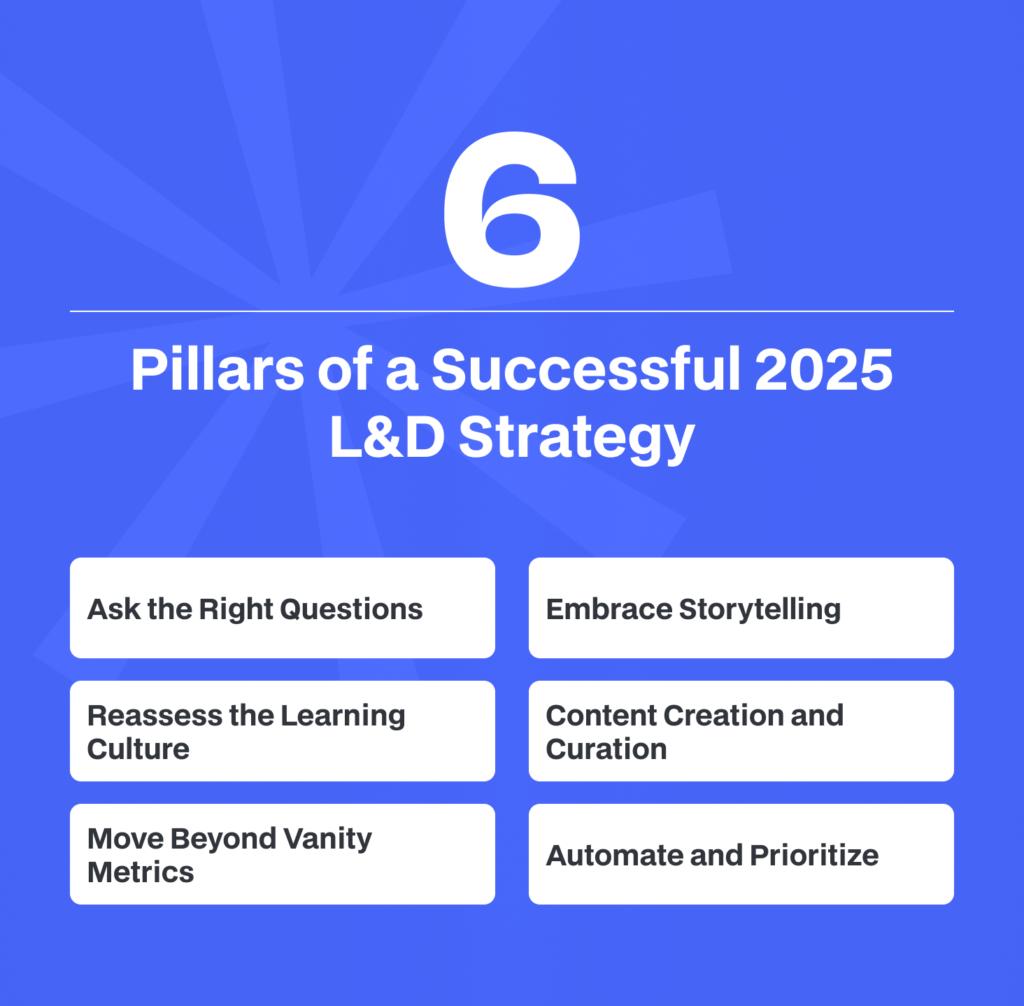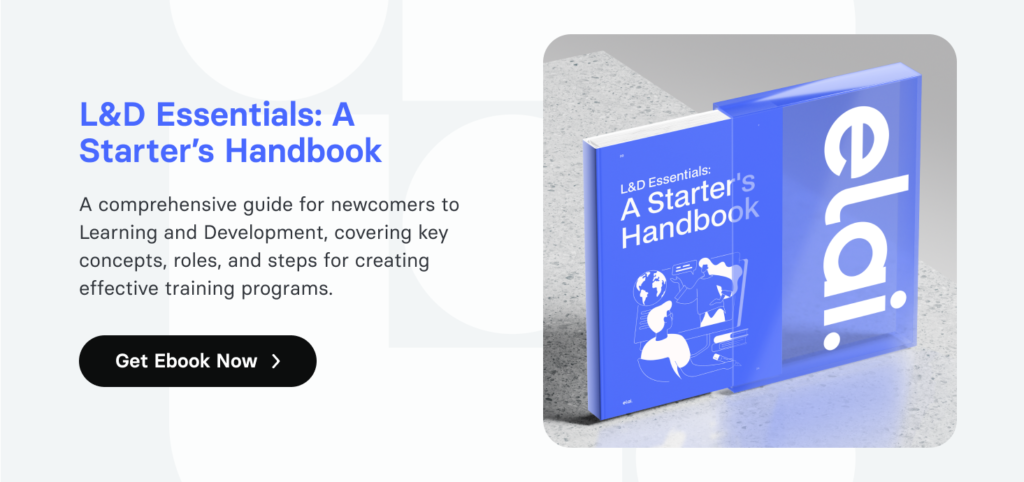As 2025 draws near, the field of Learning and Development remains a dynamic one thanks to changing technological advances, organizational and employee needs and demands. L&D leaders need to set up strategic approaches to meet both business strategic aims and learner’s goals in career upskilling. Here we’ll discuss what is important to keep in mind while constructing an L&D strategy in 2025.
Six Pillars of a Successful 2025 L&D Strategy

Ask the Right Questions
The cornerstone of any L&D strategy is the identification of organizational needs. Instead of asking “What training do we need?”, it should be “What is important for the organization, and how can we help?” This simply means starting a conversation with leaders of the businesses to understand the areas of improvement and where learning objectives and initiatives will bring positive and measurable results.
Embrace Storytelling
With these perspectives in mind, we can realize that the Learning strategy for 2025 needs to improve how it can articulate its value proposition. Stories of success, issues, and strong cases – all are sometimes more compelling than numbers on paper. What we are doing here is providing a compelling narrative of the real-world effects of learning programs so that all stakeholders can fairly appreciate the value propositions that are in store within the Learning and Development Strategy for 2025. Use cases, case studies, and narratives will drive this effort forward.
Reassess the Learning Culture
Effective culture learning is not created coincidently. 2025 is the time to assess how learning is currently considered and carried out in the organization. What succeeds and what fails? According to this evaluation, L&D teams should develop curiosity, growth, and relevance as strategic themes.
Content Creation and Curation
Today’s learners are used to quality content, thanks to its evolution around us, as well as have a natural need for inclusive delivery modes of learning. Though generating relevant and high-quality content always plays a crucial role, identifying high-quality content from unrelated or outdated and sharing it is what augments learning environments. Incorporating these two approaches guarantees that employees are offered updated, timely, and meaningful materials ready for use.
Move Beyond Vanity Metrics
Engagement rates and completion levels are just part of the big picture. Operational learning analytics is mainly about behavior, skill, and performance change and consequential business impact. The shift away from vanity metrics to actionable insights will be critical for demonstrating L&D’s ROI and aligning initiatives with organizational objectives.
Automate and Prioritize
Automating repetitive tasks like administrative tracking or basic content delivery allows L&D professionals to focus on what truly matters: aligning with the strategic directions for designing learning experiences, establishing relationships, and catalyzing learning across the institution. Having said that, there is no doubt that more organizations and businesses will benefit from the use of procedures, gadgets, and equipment that make their work an easier task to achieve.
Trends That Will Shape 2025 Learning and Development Strategy
Several trends gained momentum in 2024 and are set to define the L&D landscape in the coming year:
Artificial Intelligence (no surprise here!)
AI will also persist in disrupting L&D by offering individualized, scalable forms of learning, streamlining tedious work, and synthesizing learning data. Its ability to scale and adapt learning to individual needs will make it a cornerstone of modern L&D strategies.

Collaborative Learning
The controlling approach to training delivery wherein the trainer dominates the process, has been replaced by shared, peer-oriented learning. Peer learning enhances peer knowledge exchange, enhances identification of problems, and improves team cohesiveness. This approach will be crucial for companies who wish to design idea-generating, touchstone development experiences.

Learning in the Flow of Work (LIFOW)
Employees increasingly prefer learning integrated into their daily tasks rather than formal training sessions. LIFOW tools and platforms will ensure that learners can access knowledge when and where they need it without disrupting productivity.

Interactive Learning Content
Traditional contents that are just text, images, or videos are being swapped by improved and engaging content in the forms of games, virtual and augmented realities, and simulations in the arsenal of educationalists. Scaffolded decision trees, branching situations, and training games – this is what interactive content will look like.

L&D Strategy 2025: A Year of Purposeful Learning
L&D is more strategic than ever before as we formally enter into 2025 and organizations continue to evolve. To create an effective learning strategy organizations should focus on alignment, innovation, and the organisation&learner perspective. By actively embracing and integrating AI and other trends such as peer learning, and LIFOW, the L&D will not only amplify the value of learning as a process but also establish contractual value as a business partner that contributes to organizational objectives.
FAQ
How to build L&D Strategy for 2025?
An effective 2025 strategy for L&D starts by aligning with organizational goals rather than focusing solely on training needs. The key is understanding business objectives and designing learning initiatives supporting measurable outcomes. Reassessing the current learning culture is equally important, as it helps identify gaps and opportunities to foster curiosity and continuous growth. Emphasizing storytelling can make L&D’s impact relatable to stakeholders by sharing real-life examples and success stories. Using actionable analytics rather than vanity metrics ensures the strategy focuses on behavior change, skill acquisition, and ROI. Additionally, blending content creation with curation offers learners diverse and relevant resources, while automating repetitive tasks allows teams to prioritize innovation and high-impact projects.
What are the Learning and Development trends 2025?
Examples of trends shaping 2025 learning and development strategies are naturally connected with the importance of innovation and engagement. AI will be central in personalizing learning experiences, automating processes, and providing in-depth analytics. Collaborative learning is gaining momentum, as collaborative approaches replace traditional lectures, fostering teamwork and critical thinking. Learning in the Flow of Work (LIFOW) ensures that employees access knowledge seamlessly during daily tasks, improving relevance and productivity. Meanwhile, interactive and immersive content, such as gamification and simulations, enhances learner engagement and retention, becoming essential for future-ready L&D strategies.
Adopt these trends to create a future-ready 2025 L&D strategy framework that drives meaningful results.

